Infection Spread and High-Resolution Detection of Close Contact Behaviors
Abstract
1. Introduction
2. Materials and Methods
2.1. Room Setting
2.2. Detection Devices
2.3. Close Contact Behavior
2.4. Data Processing
3. Results
3.1. General Human Behavior Data
3.2. Indoor Behavior During Close Contact
4. Discussion
4.1. Automatically Collected Indoor Human Behavior
4.2. Close Contact Behavior
4.3. Limitations
5. Conclusions
Author Contributions
Funding
Conflicts of Interest
References
- Li, D.; Menassa, C.C.; Kamat, V.R. Non-intrusive interpretation of human thermal comfort through analysis of facial infrared thermography. Energy Build. 2018, 176, 246–261. [Google Scholar] [CrossRef]
- Bornemann, B.; Sohre, A.; Burger, P. Future governance of individual energy consumption behavior change—A framework for reflexive designs. Energy Res. Soc. Sci. 2018, 35, 140–151. [Google Scholar] [CrossRef]
- Bodin Danielsson, C.; Theorell, T. Office employees’ perception of workspace contribution: A gender and office design perspective. Environ. Behav. 2019, 51, 995–1026. [Google Scholar] [CrossRef]
- Waits, A.; Emelyanova, A.; Oksanen, A.; Abass, K.; Rautio, A. Human infectious diseases and the changing climate in the Arctic. Environ. Int. 2018, 121, 703–713. [Google Scholar] [CrossRef] [PubMed]
- Zhang, N.; Huang, H.; Su, B.; Ma, X.; Li, Y. A human behavior integrated hierarchical model of airborne disease transmission in a large city. Build. Environ. 2018, 127, 211–220. [Google Scholar] [CrossRef]
- Turgeon, N.; Hamelin, M.È.; Verreault, D.; Lévesque, A.; Rhéaume, C.; Carbonneau, J.; Checkmahomed, L.; Girard, M.; Boivin, G.; Duchaine, C. Design and validation with influenza A virus of an aerosol transmission chamber for ferrets. Int. J. Environ. Res. Public Health 2019, 16, 609. [Google Scholar] [CrossRef]
- Lee, K.M.; Jung, K. Factors influencing the response to infectious diseases: Focusing on the case of SARS and MERS in South Korea. Int. J. Environ. Res. Public Health 2019, 16, 1432. [Google Scholar] [CrossRef]
- Weber, D.J.; Rutala, W.A.; Fischer, W.A.; Kanamori, H.; Sickbert-Bennett, E.E. Emerging infectious diseases: Focus on infection control issues for novel coronaviruses (Severe Acute Respiratory Syndrome-CoV and Middle East Respiratory Syndrome-CoV), hemorrhagic fever viruses (Lassa and Ebola), and highly pathogenic avian influenza viruses, A (H5N1) and A (H7N9). Am. J. Infect. Control 2016, 44, e91–e100. [Google Scholar]
- Umar, A.A.; Sheshi, M.A.; Abubakar, A.A. Knowledge and practice of Ebola virus disease preventive measures among health workers in a tertiary hospital in Northern Nigeria. Arch. Med. Surg. 2018, 3, 1–5. [Google Scholar] [CrossRef]
- Xie, X.; Li, Y.; Chwang, A.T.; Ho, P.L.; Seto, W.H. How far droplets can move in indoor environments—Revisiting the Wells evaporation-falling curve. Indoor Air 2007, 17, 211–225. [Google Scholar] [CrossRef]
- Zhang, N.; Tang, J.W.; Li, Y. Human behavior during close contact in a graduate student office. Indoor Air 2019, 29, 577–590. [Google Scholar] [CrossRef] [PubMed]
- Liu, L.; Li, Y.; Nielsen, P.V.; Jensen, R.L. Short-range airborne transmission of expiratory droplets between two people. Indoor Air 2017, 27, 452–462. [Google Scholar] [CrossRef] [PubMed]
- Wei, J.; Li, Y. Enhanced spread of expiratory droplets by turbulence in a cough jet. Build. Environ. 2015, 93, 86–96. [Google Scholar] [CrossRef]
- Duguid, J.P. The size and the duration of air-carriage of respiratory droplets and droplet-nuclei. Epidemiol. Infect. 1946, 44, 471–479. [Google Scholar] [CrossRef]
- Loudon, R.G.; Roberts, R.M. Relation between the airborne diameters of respiratory droplets and the diameter of the stains left after recovery. Nature 1967, 213, 95–96. [Google Scholar] [CrossRef]
- Chao, C.Y.H.; Wan, M.P.; Morawska, L.; Johnson, G.R.; Ristovski, Z.D.; Hargreaves, M.; Mengersen, K.; Corbett, S.; Li, Y.; Xie, X.; et al. Characterization of expiration air jets and droplet size distributions immediately at the mouth opening. J. Aerosol Sci. 2009, 40, 122–133. [Google Scholar] [CrossRef]
- Fabian, P.; McDevitt, J.J.; DeHaan, W.H.; Fang, R.O.P.; Cowling, B.J.; Chan, K.H. Influenza virus in human exhaled breath: An observational study. PLoS ONE 2008, 3, e2691. [Google Scholar] [CrossRef]
- Xie, X.; Li, Y.; Sun, H.; Liu, L. Exhaled droplets due to talking and coughing. J. R. Soc. Interface 2009, 6, S703. [Google Scholar] [CrossRef]
- Zhang, N.; Li, Y.; Huang, H. Surface touch and its network growth in a graduate student office. Indoor Air 2018, 28, 963–972. [Google Scholar] [CrossRef]
- Ai, Z.T.; Melikov, A.K. Airborne spread of expiratory droplet nuclei between the occupants of indoor environments: A review. Indoor Air 2018, 28, 500–524. [Google Scholar] [CrossRef]
- Pantelic, J.; Tham, K.W.; Licina, D. Effectiveness of a personalized ventilation system in reducing personal exposure against directly released simulated cough droplets. Indoor Air 2015, 25, 683–693. [Google Scholar] [CrossRef] [PubMed]
- Olmedo, I.; Nielsen, P.V.; Ruiz de Adana, M.; Jensen, R.L.; Grzelecki, P. Distribution of exhaled contaminants and personal exposure in a room using three different air distribution strategies. Indoor Air 2012, 22, 64–76. [Google Scholar] [CrossRef] [PubMed]
- Cattuto, C.; Van den Broeck, W.; Barrat, A.; Colizza, V.; Pinton, J.F.; Vespignani, A. Dynamics of person-to-person interactions from distributed RFID sensor networks. PLoS ONE 2010, 5, e11596. [Google Scholar] [CrossRef] [PubMed]
- Vanhems, P.; Barrat, A.; Cattuto, C.; Pinton, J.F.; Khanafer, N.; Régis, C.; Kim, B.-A.; Comte, B.; Voirin, N. Estimating potential infection transmission routes in hospital wards using wearable proximity sensors. PLoS ONE 2013, 8, e73970. [Google Scholar] [CrossRef]
- Di Blasio, S.; Shtrepi, L.; Puglisi, G.E.; Astolfi, A. A cross-sectional survey on the impact of irrelevant speech noise on annoyance, mental health and well-being, performance and occupants’ behavior in shared and open-plan offices. Int. J. Environ. Res. Public Health 2019, 16, 280. [Google Scholar] [CrossRef]
- Davis, M.C.; Leach, D.J.; Clegg, C.W. Breaking out of open-plan: Extending social interference theory through an evaluation of contemporary offices. Environ. Behav. 2019. [Google Scholar] [CrossRef]
- Martinez-Millana, A.; Lizondo, A.; Gatta, R.; Vera, S.; Salcedo, V.T.; Fernandez-Llatas, C. Process mining dashboard in operating rooms: Analysis of staff expectations with analytic hierarchy process. Int. J. Environ. Res. Public Health 2019, 16, 199. [Google Scholar] [CrossRef]
- Alarifi, A.; Al-Salman, A.; Alsaleh, M.; Alnafessah, A.; Al-Hadhrami, S.; Al-Ammar, M.A.; Al-Khalifa, H. Ultra wideband indoor positioning technologies: Analysis and recent advances. Sensors 2016, 16, 707. [Google Scholar] [CrossRef]
- Zhang, N.; Li, Y. Transmission of influenza A in a student office based on realistic person-to-person contact and surface touch behavior. Int. J. Environ. Res. Public Health 2018, 15, 1699. [Google Scholar] [CrossRef]
- Hornbeck, T.; Naylor, D.; Segre, A.M.; Thomas, G.; Herman, T.; Polgreen, P.M. Using sensor networks to study the effect of peripatetic healthcare workers on the spread of hospital-associated infections. J. Infect. Dis. 2012, 206, 1549–1557. [Google Scholar] [CrossRef]
- Isella, L.; Romano, M.; Barrat, A.; Cattuto, C.; Colizza, V.; Van den Broeck, W.; Gesualdo, F.; Pandolfi, E.; Ravà, L.; Rizzo, C.; et al. Close encounters in a pediatric ward: Measuring face-to-face proximity and mixing patterns with wearable sensors. PLoS ONE 2011, 6, e17144. [Google Scholar] [CrossRef] [PubMed]
- Hang, J.; Li, Y.; Jin, R. The influence of human walking on the flow and airborne transmission in a six-bed isolation room: Tracer gas simulation. Build. Environ. 2014, 77, 119–134. [Google Scholar] [CrossRef]
- Lei, H.; Li, Y.; Xiao, S.; Lin, C.H.; Norris, S.L.; Wei, D.; Hu, Z.; Ji, S.; Norris, S.L. Routes of transmission of influenza A H1N1, SARS CoV, and norovirus in air cabin: Comparative analyzes. Indoor Air 2018, 28, 394–403. [Google Scholar] [CrossRef] [PubMed]
- Xiao, S.; Li, Y.; Lei, H.; Lin, C.H.; Norris, S.L.; Yang, X.; Zhao, P. Characterizing dynamic transmission of contaminants on a surface touch network. Build. Environ. 2018, 129, 107–116. [Google Scholar] [CrossRef]
- Zhang, N.; Miao, R.; Huang, H.; Chan, E.Y.Y. Contact infection of infectious disease onboard a cruise ship. Sci. Rep. 2016, 6, 38790. [Google Scholar] [CrossRef]
- Fees, B.S.; Fischer, E.; Haar, S.; Crowe, L.K. Toddler activity intensity during indoor free-play: Stand and watch. J. Nutr. Educ. Behav. 2015, 47, 170–175. [Google Scholar] [CrossRef]
- Aminian, S.; Hinckson, E.A.; Stewart, T. Modifying the classroom environment to increase standing and reduce sitting. Build. Res. Informat. 2015, 43, 631–645. [Google Scholar] [CrossRef]
- Isella, L.; Stehlé, J.; Barrat, A.; Cattuto, C.; Pinton, J.F.; Van den Broeck, W. What’s in a crowd? Analysis of face-to-face behavioral networks. J. Theor. Biol. 2011, 271, 166–180. [Google Scholar] [CrossRef]
- Salathé, M.; Kazandjieva, M.; Lee, J.W.; Levis, P.; Feldman, M.W.; Jones, J.H. A high-resolution human contact network for infectious disease transmission. Proc. Natl. Acad. Sci. USA 2010, 107, 22020–22025. [Google Scholar] [CrossRef]
- Stehlé, J.; Voirin, N.; Barrat, A.; Cattuto, C.; Isella, L.; Pinton, J.F.; Quaggiotto, M.; Broeck, W.V.D.; Regis, C.; Lina, B.; et al. High-resolution measurements of face-to-face contact patterns in a primary school. PLoS ONE 2011, 6, e23176. [Google Scholar] [CrossRef]
- Stehlé, J.; Voirin, N.; Barrat, A.; Cattuto, C.; Colizza, V.; Isella, L.; Régis, C.; Pinton, J.-F.; Khanafer, N.; Broeck, W.V.D.; et al. Simulation of an SEIR infectious disease model on the dynamic contact network of conference attendees. BMC Med. 2011, 9, 87. [Google Scholar] [CrossRef] [PubMed]
- Villafruela, J.M.; Olmedo, I.; San José, J.F. Influence of human breathing modes on airborne cross infection risk. Build. Environ. 2016, 106, 340–351. [Google Scholar] [CrossRef]
- Olmedo, I.; Nielsen, P.V.; Ruiz de Adana, M.; Jensen, R.L. The risk of airborne cross-infection in a room with vertical low-velocity ventilation. Indoor Air 2013, 23, 62–73. [Google Scholar] [CrossRef] [PubMed]
- Murakami, S.; Kato, S.; Zeng, J. Combined simulation of airflow, radiation and moisture transport for heat release from a human body. Build. Environ. 2000, 35, 489–500. [Google Scholar] [CrossRef]
- Pease, A. Body Language: How to Read others’ Thoughts by Their Gestures; Sheldon Press: London, UK, 1988. [Google Scholar]
- Rim, D.; Novoselac, A. Transport of particulate and gaseous pollutants in the vicinity of a human body. Build. Environ. 2009, 44, 1840–1849. [Google Scholar] [CrossRef]
- Nicas, M.; Best, D. A study quantifying the hand-to-face contact rate and its potential application to predicting respiratory tract infection. J. Occup. Environ. Hyg. 2008, 5, 347–352. [Google Scholar] [CrossRef]
- Heshka, S.; Nelson, Y. Interpersonal speaking distance as a function of age, sex, and relationship. Sociometry 1972, 35, 491–498. [Google Scholar] [CrossRef]
- Sorokowska, A.; Sorokowski, P.; Hilpert, P.; Cantarero, K.; Frackowiak, T.; Ahmadi, K. Preferred interpersonal distances: A global comparison. J. Cross Cult. Psychol. 2017, 48, 577–592. [Google Scholar] [CrossRef]
- Mirbagheri, S.S.; Rahmani-Rasa, A.; Farmani, F.; Amini, P.; Nikoo, M.R. Evaluating kyphosis and lordosis in students by using a flexible ruler and their relationship with severity and frequency of thoracic and lumbar pain. Asian Spine J. 2015, 9, 416. [Google Scholar] [CrossRef]
- Neupane, S.; Ali, U.; Mathew, A. Text neck syndrome-systematic review. Imp. J. Interdiscip. Res. 2017, 3, 141–148. [Google Scholar]
- McFarland, D.H. Respiratory markers of conversational interaction. J. Speech Lang. Hear. Res. 2001, 44, 128–143. [Google Scholar] [CrossRef]
- Zhang, N.; Huang, H.; Duarte, M.; Zhang, J. Dynamic population flow based risk analysis of infectious disease propagation in a metropolis. Environ. Int. 2016, 94, 369–379. [Google Scholar] [CrossRef] [PubMed]
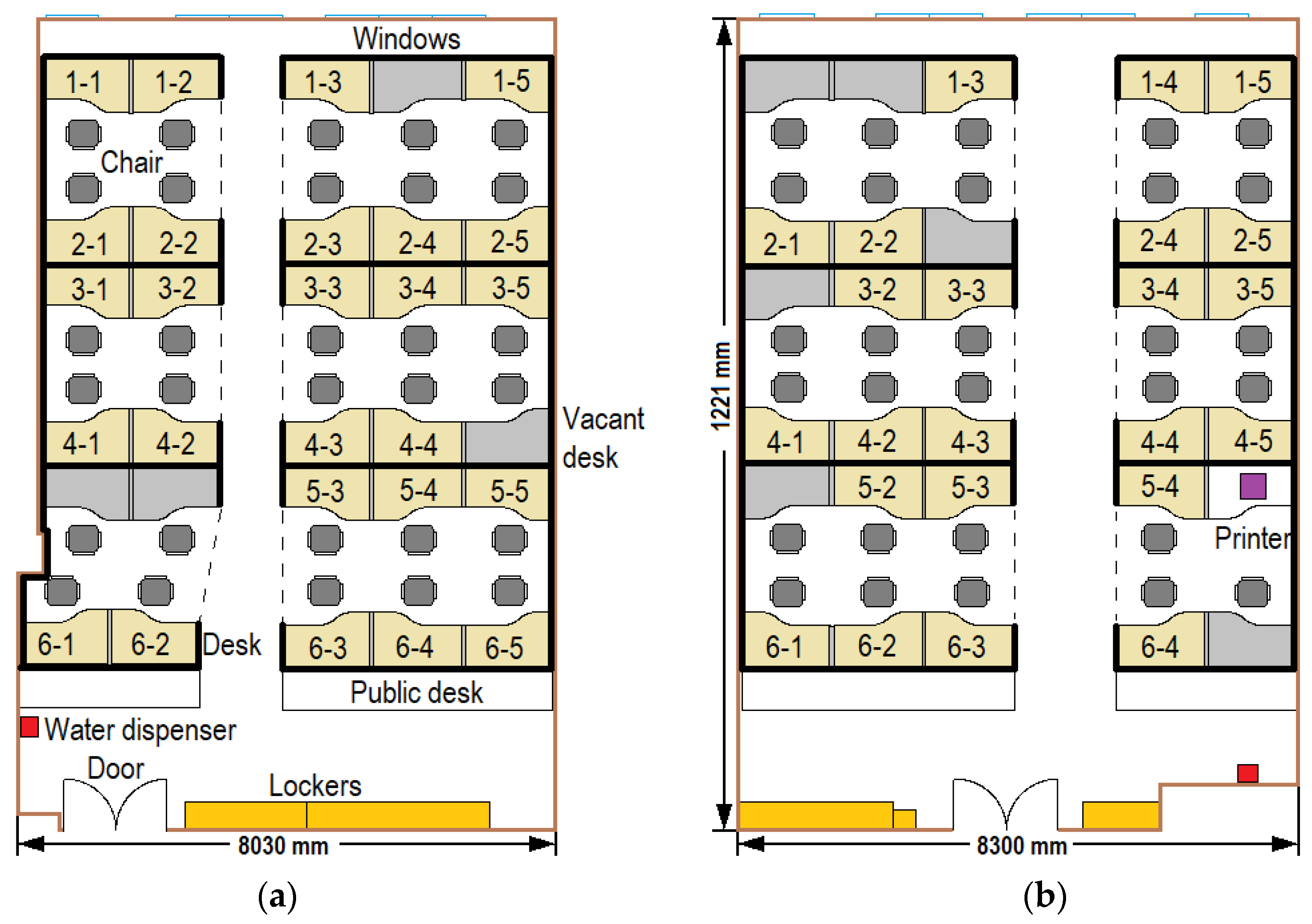
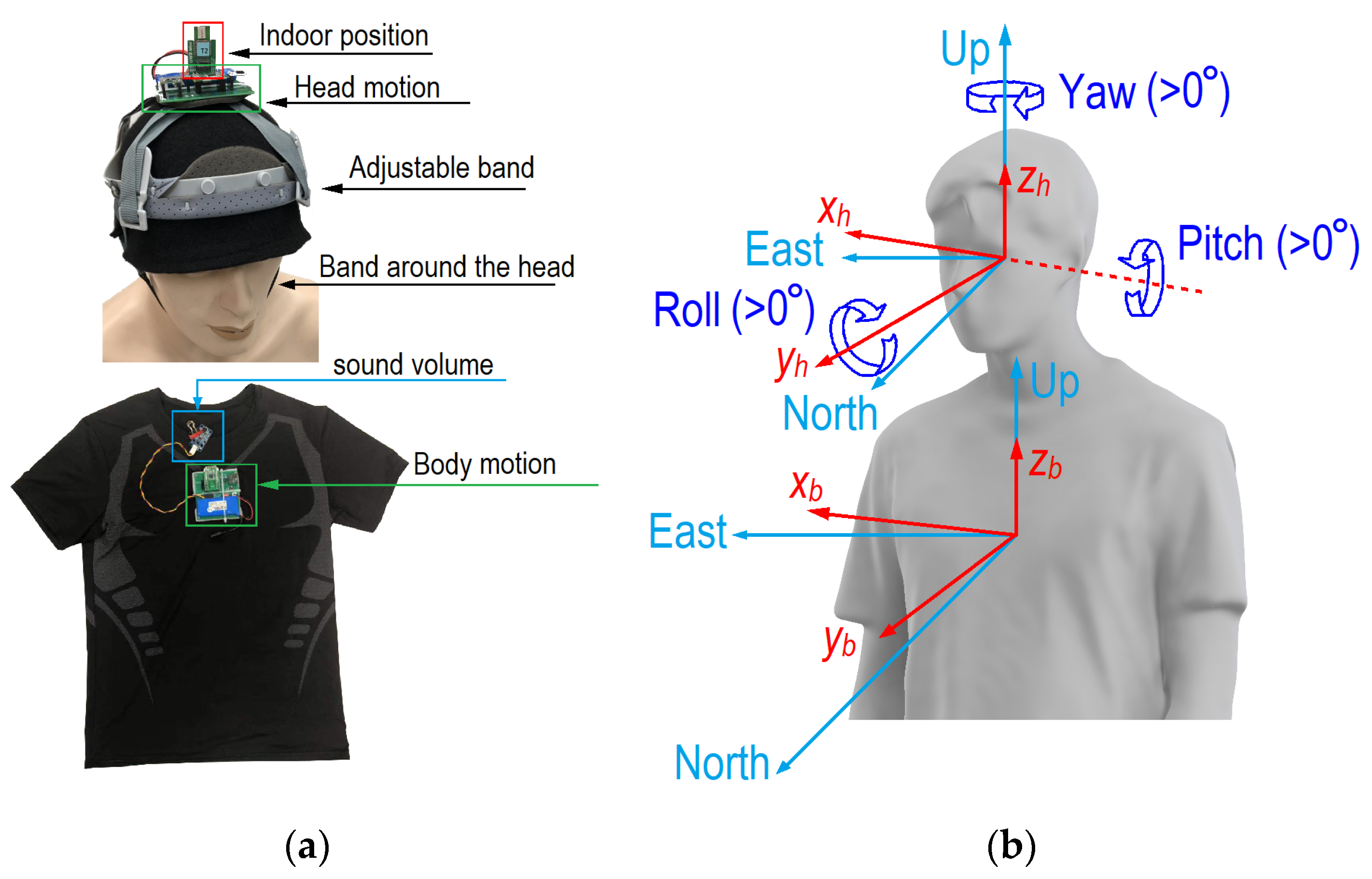
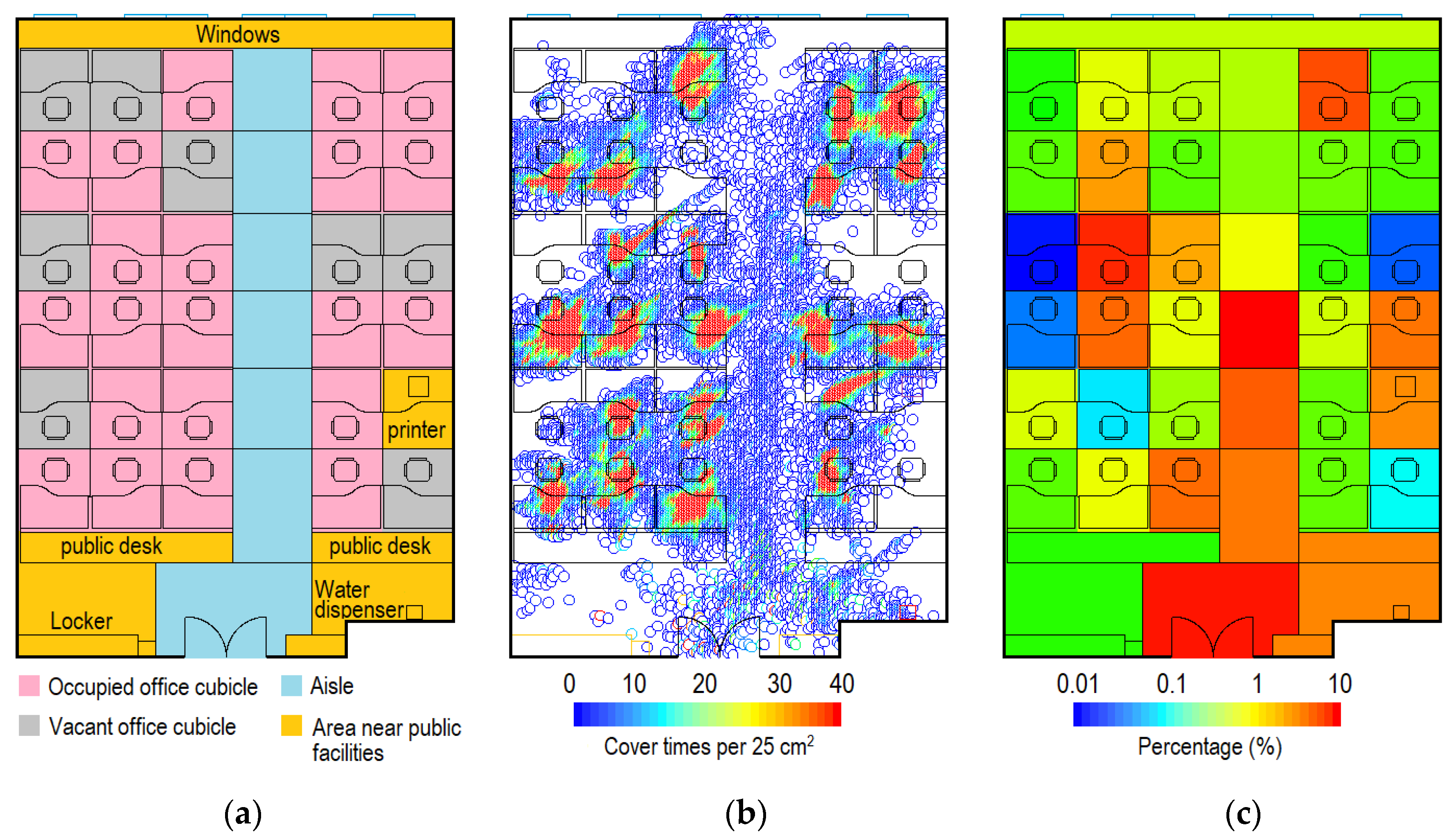
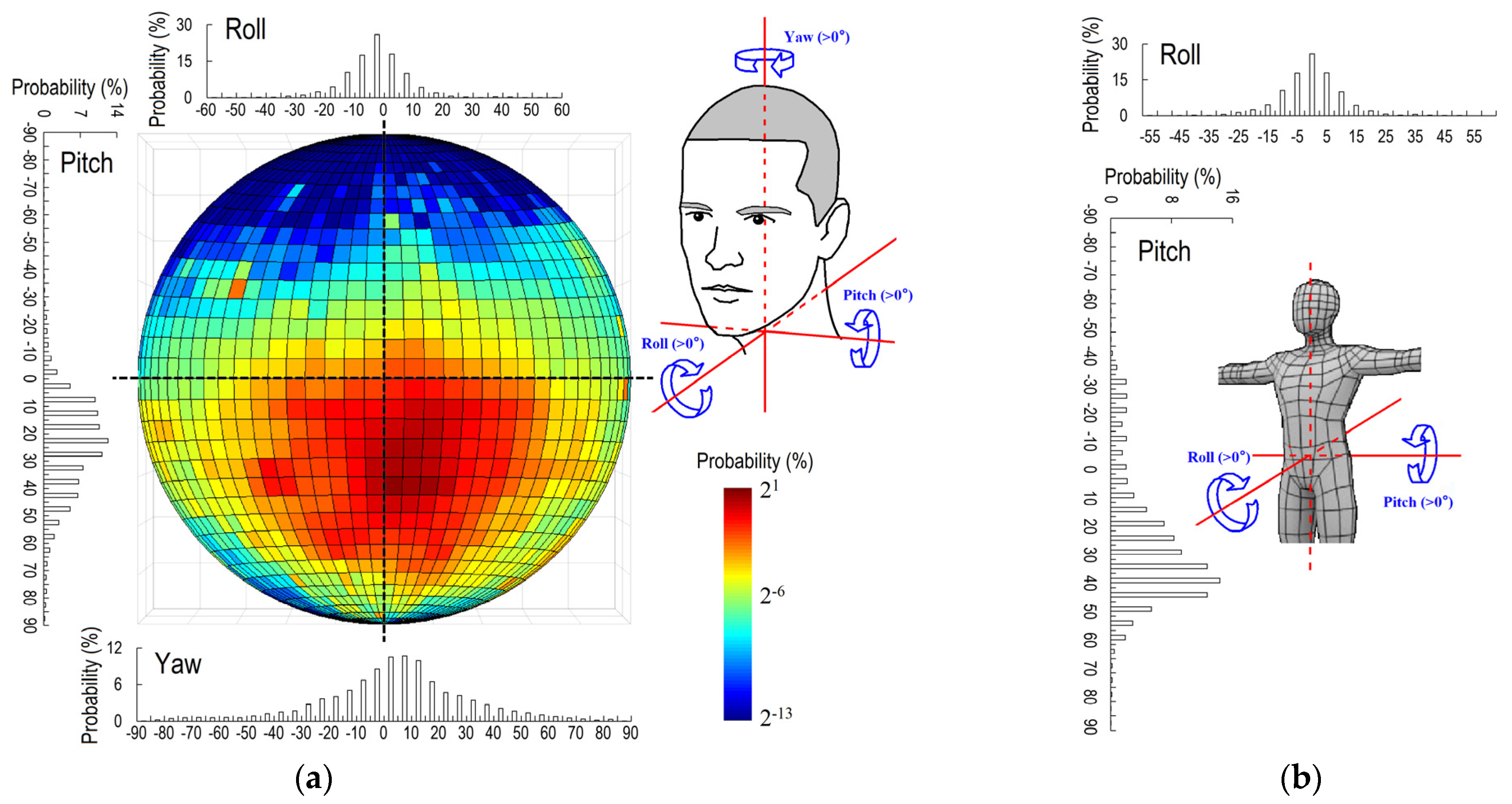
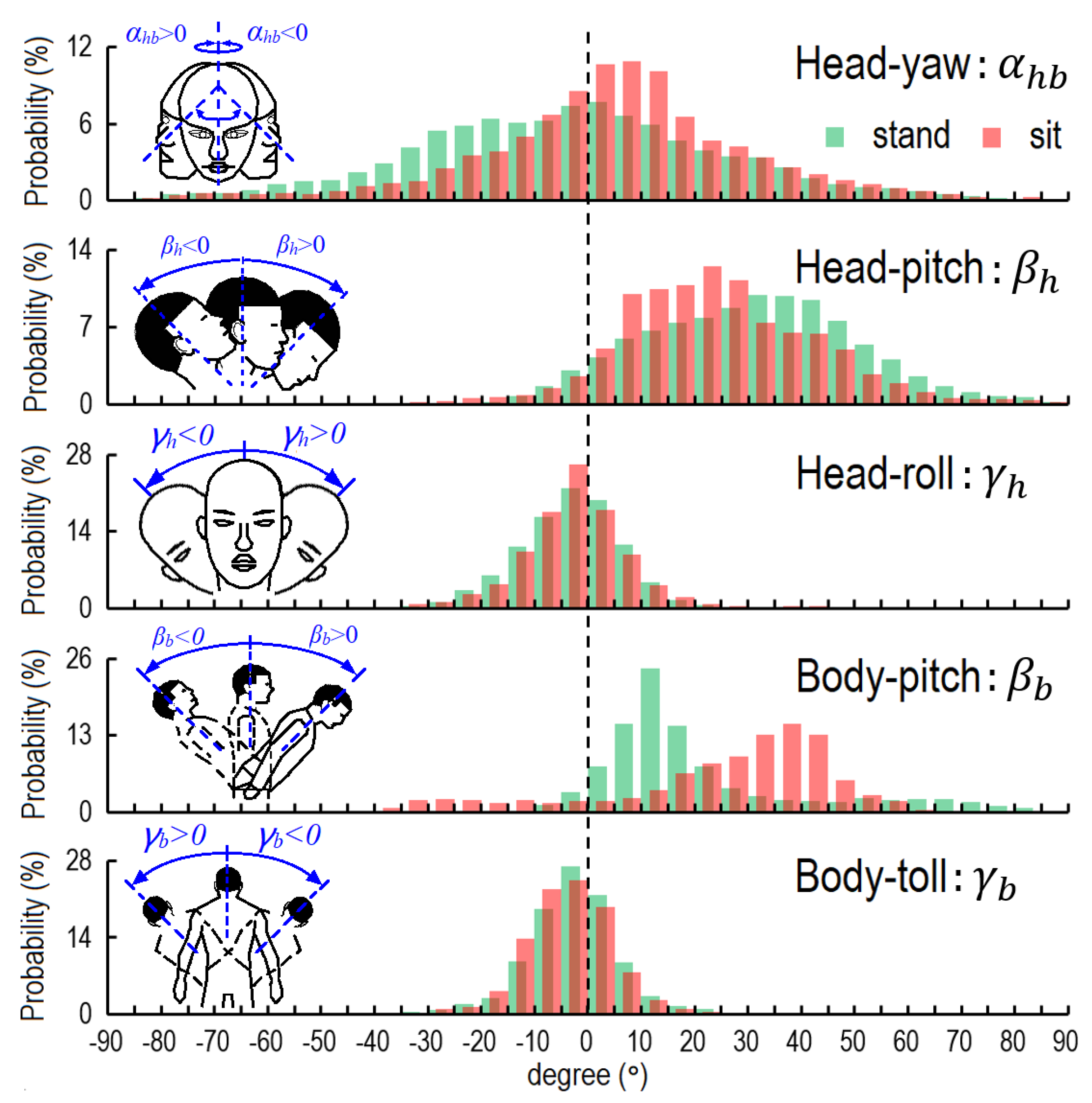
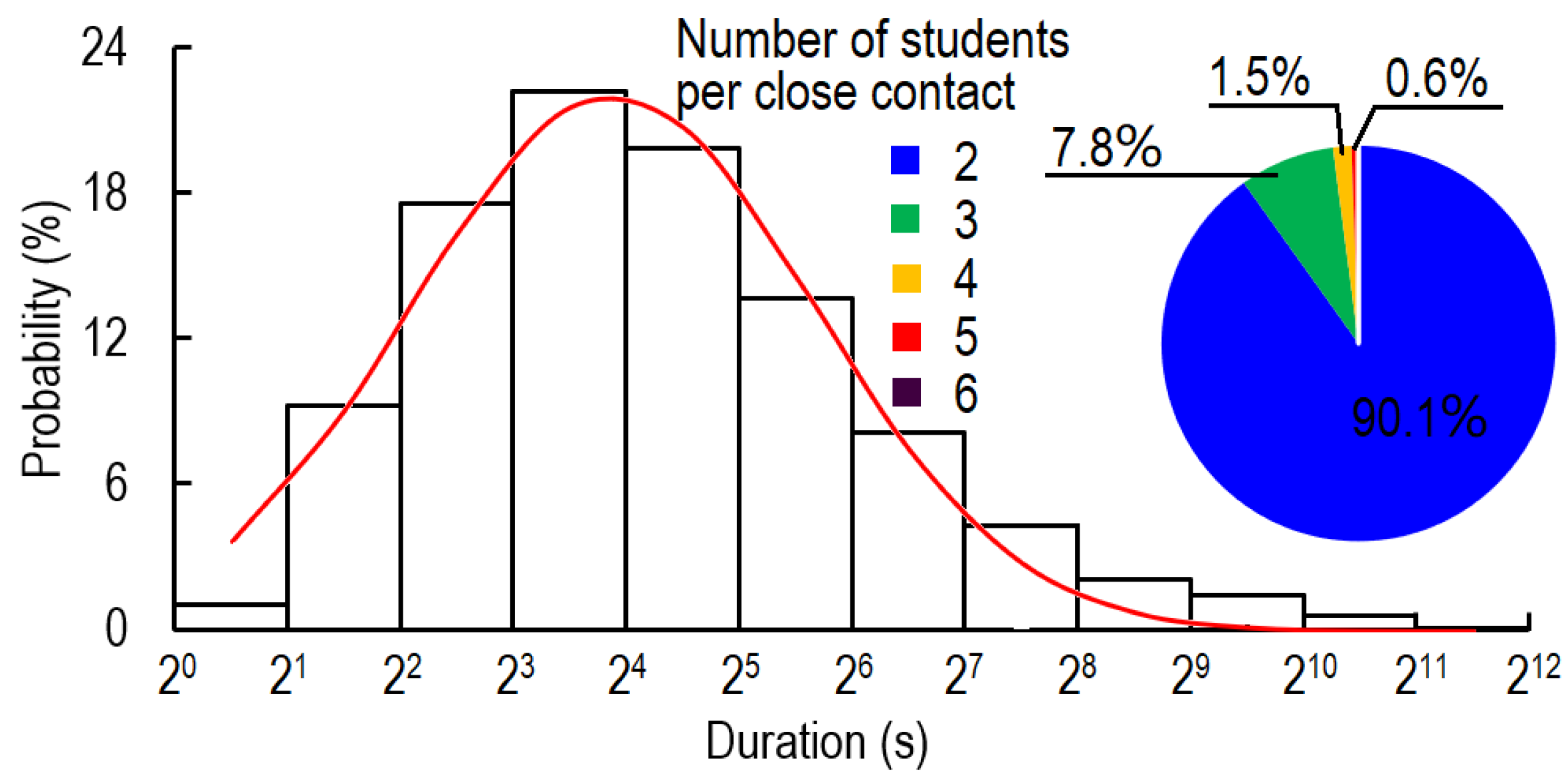

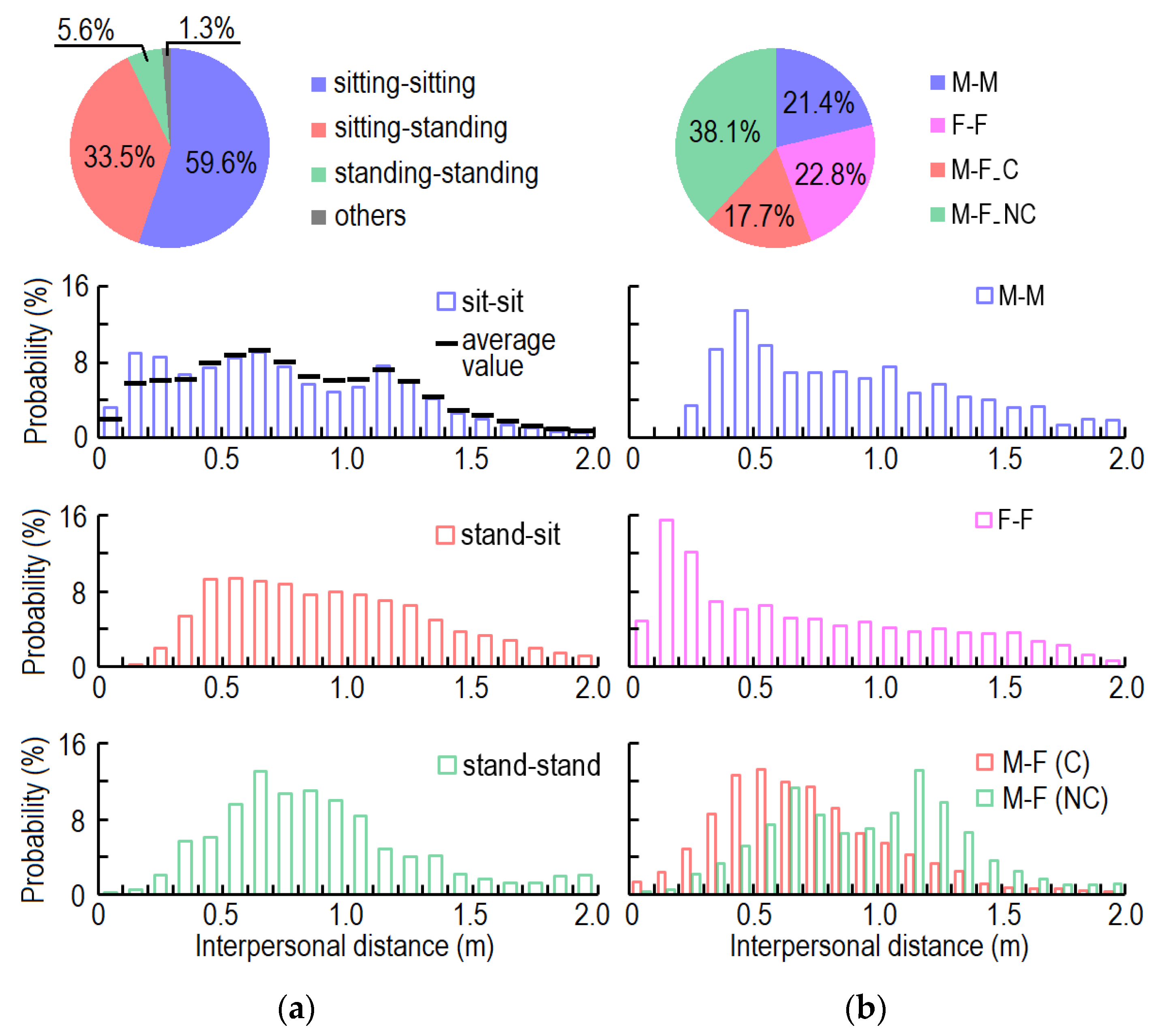
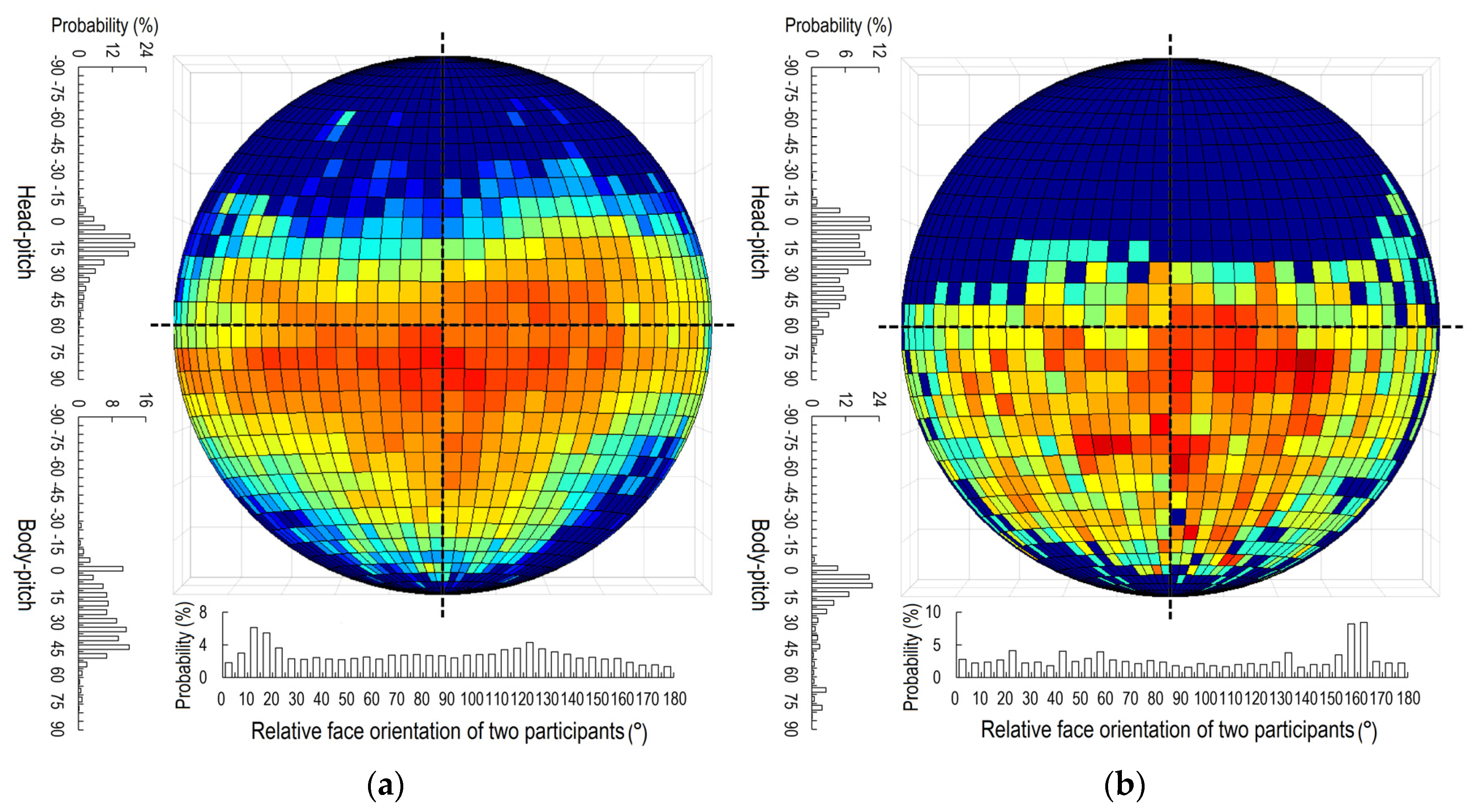
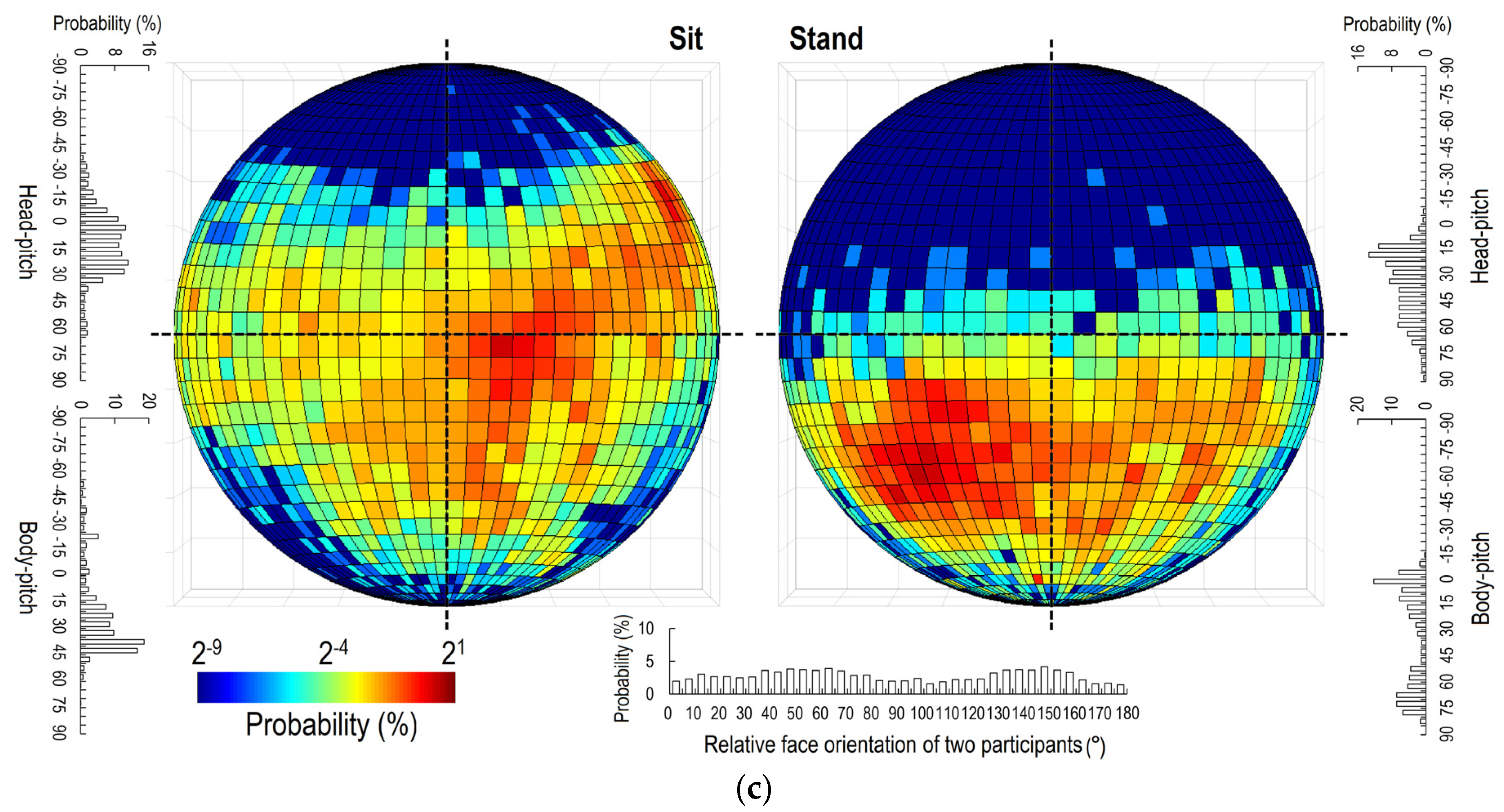
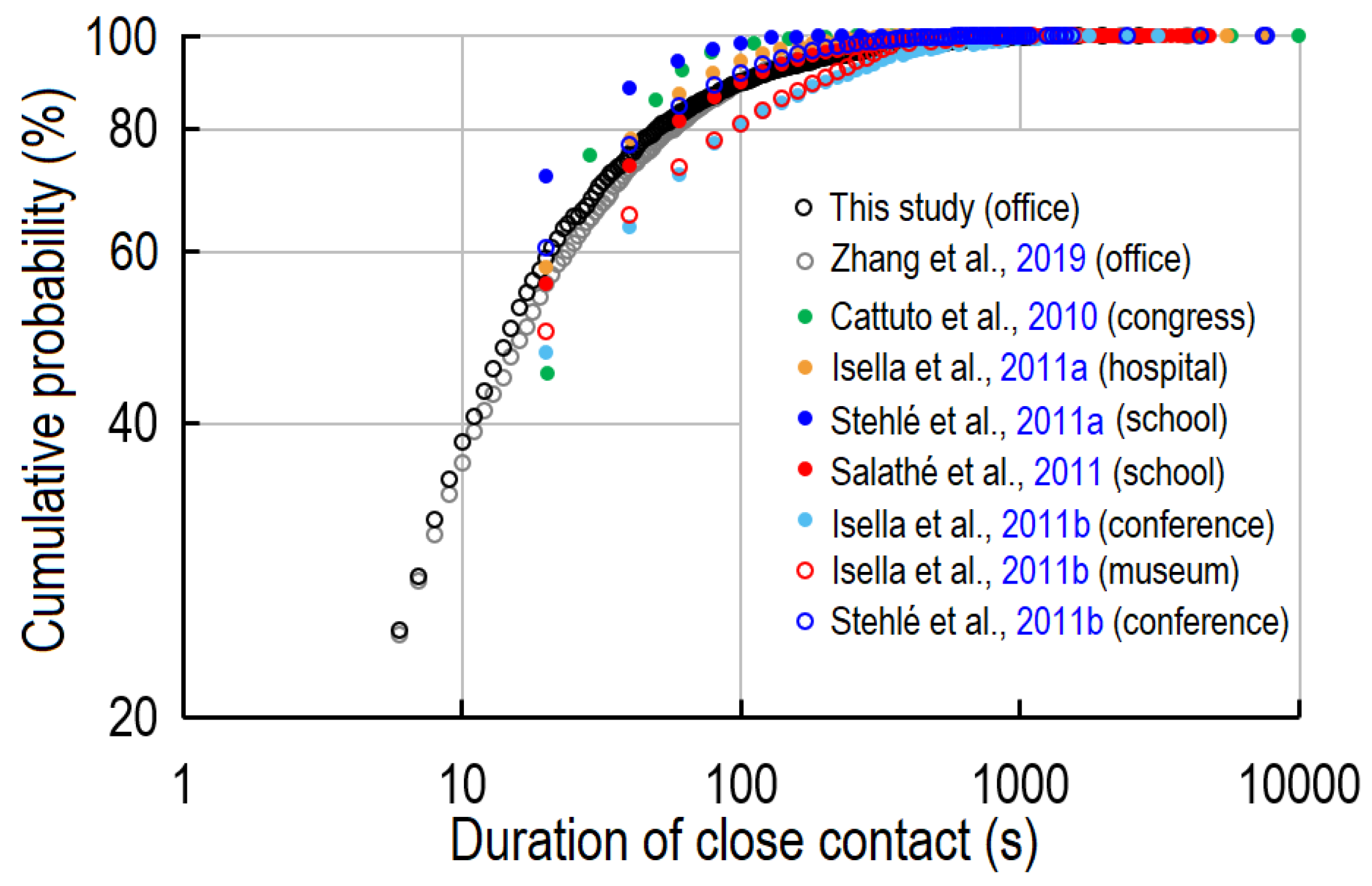
| Description | Posture | Percentage |
|---|---|---|
| Individual posture | Sitting | 76.3% |
| Standing | 22.9% | |
| Squatting | 0.8% | |
| Posture pattern | Sitting-sitting | 59.6% |
| Sitting-standing | 33.5% | |
| Standing-standing | 5.6% | |
| Sitting-squatting | 1.2% | |
| Others | 0.1% |
| Parameter. | Description | OB 1 | SB 2 | Parameter | Description | OB 1 | SB 2 |
|---|---|---|---|---|---|---|---|
| Individual posture | Sitting | 59.5% | 76.3% | Average ID 3 | 0.67 m | 0.81 m | |
| Standing | 40.4% | 22.9% | ID by gender | M-M | 0.66 m | 0.88 m | |
| Squatting | 0.1% | 0.8% | F-F | 0.55 m | 0.70 m | ||
| Posture pattern of two students | Sit-sit | 34.3% | 59.6% | M-F (NC) | 0.79 m | 0.96 m | |
| Sit-stand | 46.2% | 33.5% | M-F (C) | 0.58 m | 0.71 m | ||
| Stand-stand | 18.3% | 5.6% | ID by posture | Sit-sit | 0.59 m | 0.74 m | |
| Others | 1.2% | 1.3% | Sit-stand | 0.72 m | 0.88 m | ||
| Number of students per close contact | 2 | 87.5% | 90.1% | Stand-stand | 0.70 m | 0.93 m | |
| 3 | 11.1% | 7.8% | Head/body motion | Head (yaw) | 0.9° | 2.3° | |
| 4 | 1.2% | 1.5% | Head (pitch) | 10.3° | 17.9° | ||
| 5 | 0.1% | 0.6% | Body (pitch) | 10.6° | 25.3° | ||
| ≥6 | <0.1% | <0.1% | Body (bend) | 0.1° | 3.7° |
© 2020 by the authors. Licensee MDPI, Basel, Switzerland. This article is an open access article distributed under the terms and conditions of the Creative Commons Attribution (CC BY) license (http://creativecommons.org/licenses/by/4.0/).
Share and Cite
Zhang, N.; Su, B.; Chan, P.-T.; Miao, T.; Wang, P.; Li, Y. Infection Spread and High-Resolution Detection of Close Contact Behaviors. Int. J. Environ. Res. Public Health 2020, 17, 1445. https://doi.org/10.3390/ijerph17041445
Zhang N, Su B, Chan P-T, Miao T, Wang P, Li Y. Infection Spread and High-Resolution Detection of Close Contact Behaviors. International Journal of Environmental Research and Public Health. 2020; 17(4):1445. https://doi.org/10.3390/ijerph17041445
Chicago/Turabian StyleZhang, Nan, Boni Su, Pak-To Chan, Te Miao, Peihua Wang, and Yuguo Li. 2020. "Infection Spread and High-Resolution Detection of Close Contact Behaviors" International Journal of Environmental Research and Public Health 17, no. 4: 1445. https://doi.org/10.3390/ijerph17041445
APA StyleZhang, N., Su, B., Chan, P.-T., Miao, T., Wang, P., & Li, Y. (2020). Infection Spread and High-Resolution Detection of Close Contact Behaviors. International Journal of Environmental Research and Public Health, 17(4), 1445. https://doi.org/10.3390/ijerph17041445





